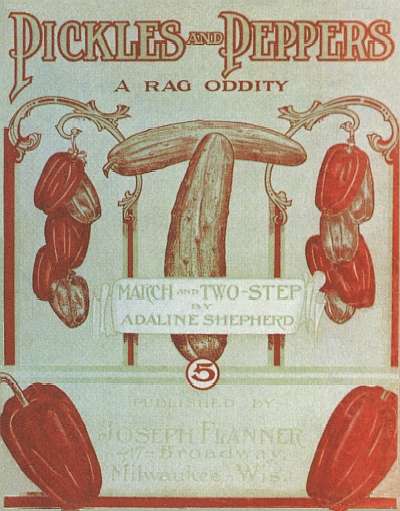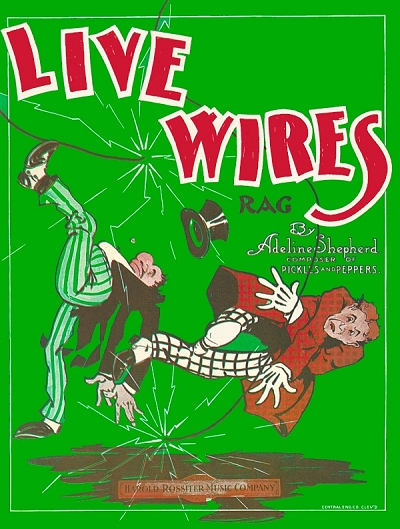|
Adaline Shepherd Olson (August 19, 1883 to March 12, 1950) | |
 Compositions Compositions | |
|
Live Wires Rag (1910)
Victory March (1917) | |
Adaline Shepherd (often erroneously seen as Adeline) was born in Iowa to Vermont native Charles Wilbur Shepherd and Massachusetts native Ella Gorarn Thissel. She was the last of three children, including Josephine Zella (1/1876), born in Wisconsin, and Harry A. (9/23/1881). One other sibling died in infancy. Adaline was often called Addie well into her twenties, including for some enumerations. The 1885 Iowa census showed the family living in Algona, with Charles working in a paint shop.
It is likely that Adaline's early education included some music instruction at the piano, common for girls at that time. However, she was largely untrained in composition or theory, and mostly self-taught. The family moved to Berlin, Wisconsin, near lake Winnebago sometime in the mid-1890s. The 1900 census showed them living there with Charles now working as a grocer. By 1905 the family had moved southwest to Muscoda, Wisconsin and Charles was working for a hotel there as was Harry, while Addie was working in a hat shop or factory. By 1907, when she was 21-years-old, Addie and her family had moved to Milwaukee, Wisconsin.
The family moved to Berlin, Wisconsin, near lake Winnebago sometime in the mid-1890s. The 1900 census showed them living there with Charles now working as a grocer. By 1905 the family had moved southwest to Muscoda, Wisconsin and Charles was working for a hotel there as was Harry, while Addie was working in a hat shop or factory. By 1907, when she was 21-years-old, Addie and her family had moved to Milwaukee, Wisconsin.
 The family moved to Berlin, Wisconsin, near lake Winnebago sometime in the mid-1890s. The 1900 census showed them living there with Charles now working as a grocer. By 1905 the family had moved southwest to Muscoda, Wisconsin and Charles was working for a hotel there as was Harry, while Addie was working in a hat shop or factory. By 1907, when she was 21-years-old, Addie and her family had moved to Milwaukee, Wisconsin.
The family moved to Berlin, Wisconsin, near lake Winnebago sometime in the mid-1890s. The 1900 census showed them living there with Charles now working as a grocer. By 1905 the family had moved southwest to Muscoda, Wisconsin and Charles was working for a hotel there as was Harry, while Addie was working in a hat shop or factory. By 1907, when she was 21-years-old, Addie and her family had moved to Milwaukee, Wisconsin.It was in Milwaukee that Addie presented a ragtime piece to publisher Joseph Flanner. He was impressed enough with what he heard to have the piece notated from her playing, and not only did it become her most famous piano rag, Pickles and Peppers is likely the most popular rag ever written by any woman. Given Shepherd's obscurity in history it is amazing how popular this rag quickly became. It eventually eclipsed 2 million copies, and the hymn-like trio was readily adopted as the official musical theme for the unsuccessful presidential candidacy of William Jennings Bryan in 1908. Pickles and Peppers became as popular with bands as it did with pianists.
An article on Shepherd and her popular piece was published in the Evening Wisconsin of September 29, 1908:

"Pickles and Peppers" originated with Miss Adaline Shepherd, a young woman living on the West Side [of Milwaukee]. The peculiar thing about the composition of the piece is that the author does not know a note of music and yet is an accomplished pianist, playing entirely by ear. She did not write the music. One day in the summer of 1907 Miss Shepherd told Joseph Flanner she had an instrumental composition on which she desired his opinion. When the [Milwaukee] music publisher asked to see her notes, the young woman replied she had none, that the music was in her head. Thereupon he asked Miss Shepherd to play it for him. This she did and Mr. Flanner admits now that during the first two or three bars his mind was not concentrated on the girl playing beside him. In a moment, however, Mr. Flanner's trained musical ear began to assume closer attention. When the girl had finished, the publisher said nothing in praise or dispraise, further than to ask her to call again next day at the same hour. Mr. Flanner requested a bandmaster to meet the girl, and after she had played the piece to the two gentlemen, the bandmaster declared his willingness to write [transcribe] the music for it, although, like all orchestra leaders, he expressed his abhorrence for all "rag" music. Not long thereafter the instrumental music was placed on the market. The piece instantly made a hit.
Shepherd followed her debut with two more worthwhile rags, similarly composed by her and notated by an arranger, but Flanner did not publish them. Neither of them came close to matching the popularity of her first piece, and her output stopped for a while at three. The Shepherd family, minus Josephine, who was married in 1901, was shown living in Milwaukee in the 1910 census with Addie still working as a milliner, and Harry now employed as a railroad engineer.
Addie married appraiser Frederick S. Olson later that year. It was likely that Adaline, like so many other female composers, gave up her potential musical career to raise a family, including the couple's daughters Jean (1913) and Dorothy (1916), and their son Frederick Jr. (1920). Still, one further piece is known to have come from Addie during The Great War (World War I) in 1918. It was Victory March, and she penned it as Mrs. F. S. Olson.
The Olson family appeared in Milwaukee in the 1920 census with Frederick still employed by an appraisal company as a supervisor, but Adaline with no occupation other than mother and housewife. They were in the same location in 1930 with Fred now promoted to the position of president of the appraisal firm. Addie's mother, Ella, now widowed, was living with them. The 1940 census showed the same situation, and Adaline still listed no occupation.
In later years it was reported that Addie felt her works were either unimportant or not very good, in spite of their popularity speaking to the contrary. Her family did not particularly support her musical passion either, sadly showing little interest in it. Mrs. Olson lived the remainder of her evidently musically uneventful life in Milwaukee, passing on at age 76 in 1950.